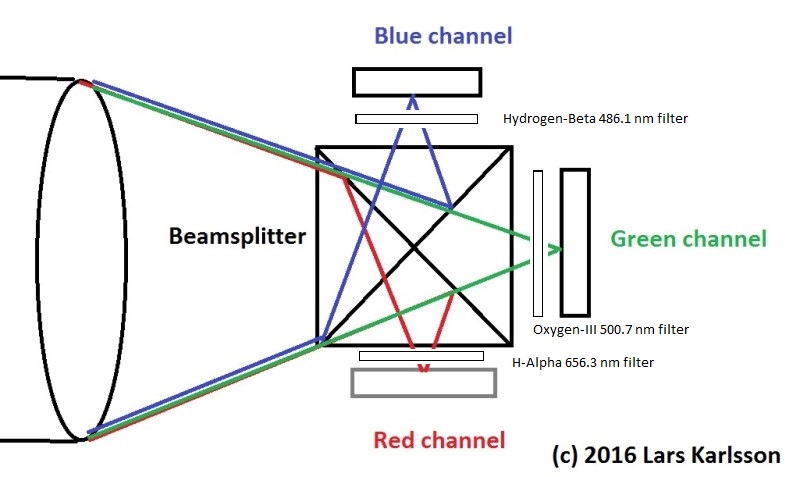|
Advertisement / Annons: |
Project:
|
|
Content: |
|
1: Introduction(I continuously update and correct, I don't take any risk if you use this information and built something from it) I wrote this down because of bad weather and boring times, as usual. This project will be to complicated for me to built, but I have thought about it for many years. When doing narrow band imaging you have to do very long exposures to get enough high S/N, Signal /Noise relation. Normally you don't only want the single H-Alpha line, better with three lines to built a rgb image at the end. Then you have to repeat this process of long time exposures three times. Every time you do this you just block the two other lines, can't you collect the two others in the same time? Already when doing three color images you waste a lot of time because not doing the three rgb channels in parallel, maybe you read this? This is just an idea from me how to built a telescope / camera system that do three line exposures in parallel. In theory three times more efficient.
|
2: Information about narrow band filterFirst a collection of links about narrow band filter imaging:
As you see there are a lot of interesting astronomy imaging to do with narrow band filter.
|
3: Beam splitterOne way is of course to have three telescopes with each narrow band filter and camera. It works and with a heavy mount you can have all three of them on the same mount. But three telescopes and three cameras cost a lot of money and take a lot of space and also need a very sturdy and expensive mount. If you hade a single sensor color camera with instead of red, green and blue filter hade three narrow band filter you have a great solution, one telescope and one camera. But then you have too wait for a very long time until someone built a camera like that. And of course it don't use all the pixel for each wavelength, maybe an advanced construction like the Foveon cameras. One solution that could be built already today is a optical system with one telescope and three cameras. What you need to built something like that is a beam splitter. With a beam splitter you divide the light beam in separate paths with different wave lengths. Sounds difficult? No, they have been there for several years in video color cameras, already in the old color vidicon cameras from 1960s.
If you can find a camera that old and take the beam splitter from it you maybe can do this. 
That vidicon color camera beam splitter divide the beam on read, green and blue channels with a vidicon camera at each beam. Older video cameras uses bigger tubes and then have bigger beam splitters which is good to us. The illustrations above is the simplest form, there are other ways to arrange the surfaces of the beam splitters. There are beam splitter also in more modern three sensor CCD cameras, but they has very small sizes.
In the example I have placed extra narrow band filters in front of each astrocamera. The green Oxygen-III channel could be a problem because it fit in the wave length between the blue and green channels. The telescope must have a long back focus, maybe the beam splitter needs 50 mm for an APS-C sensor, on the other hand there is no need for a filter wheel.
Update:
|
4: Built your own specialized beam splitterIt must be possible to build your own designed beam splitter. Maybe there are so simple that you can find the parts at Edmunds optics.
Plate splitters could give ghost reflections. Interference filters normally reflect most of the light it don't let through, astronomy narrow band filters are of interference construction. It could have been a solution to use ordinary narrow band filters but when tilted them like in the illustrations above they change its optical behavior and shift the wavelength it put through, if it let anything through in 45 degrees angle at all. I will be back when I have looked through the Edmund Optics beam splitters or some other supplier. There are other use of beam splitters. Maybe you have seen the guider systems that separate the IR wavelengths and guide on them.
Very interesting article about guiding in the NIR wavelengths, maybe only possible to reach this precision with an AO (Adaptive Optics) unit. It's easy to test if it will give any benefits in your own auto guiding system, just put in a NIR (700-1000nm) transmission filter to the guide camera. Maybe we shall have a four way splitter, r,g,b,NIR ? But difficult to get the needed space for it.
|
| Go Back |